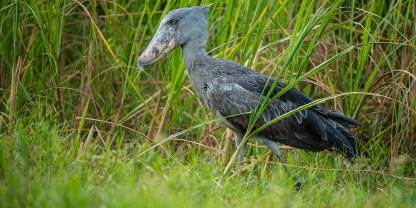Average Expert Rating
Rating Breakdown
Write a User ReviewAway From the Main Tourist Circuit, the Devil’s in the Detail
The northern boundary of the 543km2 Toro National Park is Lake Albert, a reliable place to jump in a boat in search of the shoebill. (Just close your eyes when you drive through the rather grotty fishing
Read more
village of Ntoroko.)If you want to get away from it all, Toro is that place. Set in the middle of the park, the high-end Semliki Safari Lodge tented camp is the only place worth staying. Not only is it a great location, the owners have two decades’ experience collaborating on conservation initiatives.
Expect to hear your ears pop as you zigzag down the Kijura Escarpment, the only road in/out of Toro.
Where Chimpanzees and Shoebills Reside
Situated in the heart of the Albertine Rift and bordering majestic Lake Albert, this park lies well off the beaten track. Wildlife numbers are generally still low, but elephant sightings are fairly reliable and I have enjoyed my best ever shoebill viewing here. Keen birders will surely twitter when they hear I once saw 13 shoebills in a single day boating through the reeded islands of Lake Albert. The park also offers energetic safari enthusiasts a chance to join researchers as they track semi-habituated chimps. But, be warned, it’s a long, hard day of walking and you seldom get much more than a glimpse of the elusive primates before they take off deeper into the forest. In summation, I would say that Toro is a park for the African explorer rather than the wildlife enthusiast.
Uganda’s Forgotten Valley
The spectacular tar road from the highland town of Fort Portal to the Semliki Valley ranks among the most scenic drives in Uganda. Once in the park, wildlife viewing is a bit hit-and-miss, but you are sure to see Uganda kob, buffalo, and black-and-white colobus. Leopard and giant forest hog are also seen from time to time and it is one of the few places where the widespread African bush elephant occurs alongside the more closed and smaller African forest elephant (these are now regarded to be a separate species). Also on offer are forest walks with the possibility of seeing semi-habituated chimpanzees.
Read more
My favourite activity in Toro is boat trips on Lake Albert, a scenic lake enclosed by the sheer walls of the Rift Valley. The lake is home to a wealth of birdlife, with the eagerly sought shoebill and stunning red-throated bee-eater both conspicuous. The solitary upmarket lodge in Toro has a great wilderness atmosphere, and it offers ready access to nearby Semuliki National Park, an extension of the Congolese Ituri Rainforest, where a full 35 bird species known from no other locality in East Africa are resident.
The Hot Semliki Valley – a Birder’s Paradise
Toro National Park (formerly Toro-Semliki Wildlife Reserve) lies in the Semliki Valley, which is reached by descending the long, windy tar road from Fort Portal. There are several viewpoints en route that are worth stopping at. The hot valley has a real wilderness feel, but unfortunately wildlife is sparse due to abundant poaching in the past. We didn’t see many mammals aside from some skittish elephants, good-sized herds of kobs and some warthog tails sticking out of the long grass like little antennas. The birding, on the other hand, is very good, especially if you head out to the forest. Another highlight was a boat trip on Lake Edward. The fishermen are known to direct visitors to good shoebill sightings, but we headed out to see the stunning Nkusi Falls coming down the Rift Valley. Not as impressive as Murchison Falls, but rarely seen by tourists, it felt like a real gem to be discovered by us after a long adventurous journey.
Meet the Chimpanzees of the Savannah
Uganda’s oldest nature preserve is where the Central African rainforest merges into the East African savannah, creating both a lovely landscape and diverse habitat. The beauty and diversity are boosted by the eastern escarpment of the Great Rift Valley running the length of the park. Because of the comparatively low wildlife numbers, Toro is not featured on many safari itineraries and has just one luxury lodge, which means you won’t meet many other vehicles out in the savannah. Despite this, there’s a good chance to see elephant (both the savannah and forest species), buffalo, leopard and many of the larger antelope. Lake Albert boat trips let you see hippos, crocodiles and the so-ugly-it’s-cute shoebill stork. Night drives and bushwalks (I recommend the primate-filled Nyaburogo Gorge) are also available. Although Toro is home to a semi-habituated chimpanzee community, tracking trips to find them in the forest are often unsuccessful.

